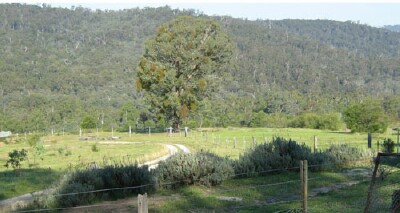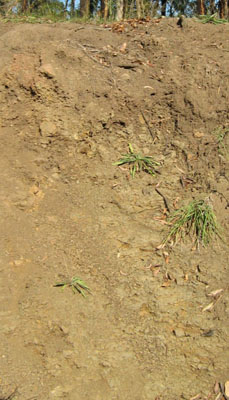EGW78
Location: W Tree
Australian Soil Classification: Melanic, Eutrophic, Red FERROSOL
Map Unit: W Tree (Component 1, crest)
Previous Site Name: EG78
General Landscape Description: Plateau
Site Description: Lower slope, 2% slope
Land Use: Grazing
Native Vegetation: Valley grassy woodland
Geology: Tertiary basalt

The steep wooded hills in the background are mapped as the Carrabungla map unit.
Soil Profile Morphology:
| Surface soil |  | ||
| A | 0 – 35 cm | Dark reddish brown (5YR3/2); clay loam; strong medium polyhedral structure, parting to very fine polyhedral structure; weak consistence moderately moist; pH 6.2; clear change to: | |
| Subsoil | |||
| B2 | 35 - 55+cm | Dark reddish brown (2.5YR3/4); medium clay; strong coarse polyhedral parting to fine polyhedral structure; firm consistence moist; pH 6.2. |
Key Profile Features:
- Deep, strongly structured soil profile
Soil Profile Characteristics:
- | pH | Salinity | ||
Surface soil (A horizon) | Slightly Acid | Very Low | Non-sodic | None |
Subsoil (B2 horizon) | Slightly Acid | Very Low | Non-sodic | None |
Chemical and Physical Analysis:
Horizon | Horizon Depth (cm) | pH (water) | pH (CaCl2) | EC dS/m | Organic Carbon % | Total Nitrogen % | Free Fe2O3 % w/w | Exchangeable Aluminium ppm | Exchangeable Acididty meq/100g | Exchangeable Cations | Coarse Sand (0.2-2.0 mm) % | Fine Sand (0.02-0.2 mm) % | Silt (0.002-0.02 mm) % | Clay (<0.002 mm) % | Field Capacity % w/w | Wilting Point % w/w | |||
Ca | Mg | K | Na | ||||||||||||||||
meq/100g | |||||||||||||||||||
A | 0-35 | 6.2 | 5.2 | <0.05 | 4.0 | 0.26 | 6.1 | <1 | 19.0 | 9.2 | 4.2 | 0.92 | 0.19 | 7 | 22 | 27 | 34 | 42.4 | 17.9 |
B2 | 35-55 | 6.2 | 5.3 | <0.05 | 8.1 | <1 | 13.0 | 6.7 | 4.5 | 0.48 | 0.23 | 4 | 14 | 16 | 63 | 43.5 | 29.3 | ||
Management Considerations
Whole profile
- The profile is slightly acid throughout.
- These soils are very well drained due to their strongly developed subsoil structure.
- There is little restriction to roots throughout the profile.
- Plant available water capacity is considered to be high; estimated at 130+ mm, based on the laboratory data and the depth of soil available to plant roots.
- The nutrient holding capacity of the soil is moderate (based on the sum of the exchangeable cations).
- The soils are high in iron oxide, but the pH is probably high enough to minimise phosphorus fixation.
- Potassium levels are high.
- The friable nature of the subsoil allows very deep penetration of plant roots.
- The friable nature of the subsoil can lead to problems with sealing of earth dams.
Profile Described By: David Rees and Grant Boyle, 2000.


